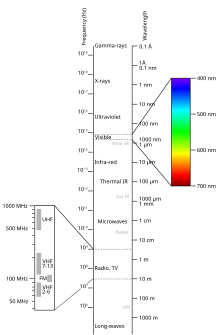Electromagnetic radiation - Simple English Wikipedia, the free encyclopedia
| Electromagnetism |
|---|
 |
| Electricity · Magnetism · Magnetic permeability |

Electromagnetic waves are waves that contain an electric field and a magnetic field and carry energy. They travel at the speed of light[1] (299,792,458 meters per second).
Quantum mechanics developed from the study of electromagnetic waves. This field includes the study of both visible and invisible light. Visible light is the light one can see with normal eyesight in the colours of the rainbow. Invisible light is light one can't see with normal eyesight and includes more energetic and higher frequency waves, such as ultraviolet, x-rays and gamma rays. Waves with longer lengths, such as infrared, micro and radio waves, are also explored in the field of Quantum mechanics.
Some types of electromagnetic radiation, such as X-rays, are ionizing radiation and can be harmful to your body.[2] Ultraviolet rays are near the violet end of the light spectrum and infrared are near the red end. Infrared rays are used as heat rays and ultraviolet rays cause sunburn.
The various parts of the electromagnetic spectrum differ in wavelength, frequency and quantum energy.
Sound waves are not electromagnetic waves but waves of pressure in air, water or any other substance.[3]
Mathematical formulation[change | change source]
In physics, it is well known that the wave equation for a typical wave is
The problem now is to prove that Maxwell's equations explicitly prove that the electric and magnetic fields create electromagnetic radiation. Recall that two of Maxwell's equations are given by
By evaluating the curl of the above equations and vector calculus one can prove the following equations
Note: the proof involves making the substitution
The equations above are analogous to the wave equation, by replacing f with E and B. The above equations mean that propagations through the magnetic (B) and electric (E) fields will produce waves.
Related pages[change | change source]
References[change | change source]
- ↑ This is always defined as the speed of propagation in a vacuum Speeds through various material substances vary.
- ↑ "Ionizing Radiation". Centers for Disease Control and Prevention. 2021-06-29. Retrieved 2023-11-22.
- ↑ "Sound waves". Vedantu. Retrieved 22 November 2023.
- Hecht, Eugene (2001). Optics (4th ed.). Pearson Education. ISBN 0-8053-8566-5.
- Serway, Raymond A.; Jewett, John W. (2004). Physics for Scientists and Engineers (6th ed.). Brooks/Cole. ISBN 0-534-40842-7.
- Tipler, Paul (2004). Physics for Scientists and Engineers: Electricity, Magnetism, Light, and Elementary Modern Physics (5th ed.). W. H. Freeman. ISBN 0-7167-0810-8.
- Reitz, John; Milford, Frederick and Christy, Robert (1992). Foundations of Electromagnetic Theory (4th ed.). Addison Wesley. ISBN 0-201-52624-7.
{{cite book}}: CS1 maint: multiple names: authors list (link) - Jackson, John David (1975). Classical Electrodynamics (2nd ed.). John Wiley & Sons. ISBN 0-471-43132-X.
- Allen Taflove and Susan C. Hagness (2005). Computational Electrodynamics: The Finite-Difference Time-Domain Method, 3rd ed. Artech House Publishers. ISBN 1-58053-832-0.
Other websites[change | change source]
- Electromagnetic Waves from Maxwell's Equations Archived 2007-07-10 at the Wayback Machine on Project PHYSNET.
- Conversion of frequency to wavelength and back - electromagnetic, radio and sound waves Archived 2012-03-11 at the Wayback Machine
- eBooks on Electromagnetic radiation and RF
- The Science of Spectroscopy Archived 2019-03-23 at the Wayback Machine - supported by NASA. Spectroscopy education wiki and films - introduction to light, its uses in NASA, space science, astronomy, medicine & health, environmental research, and consumer products.


 French
French Deutsch
Deutsch




